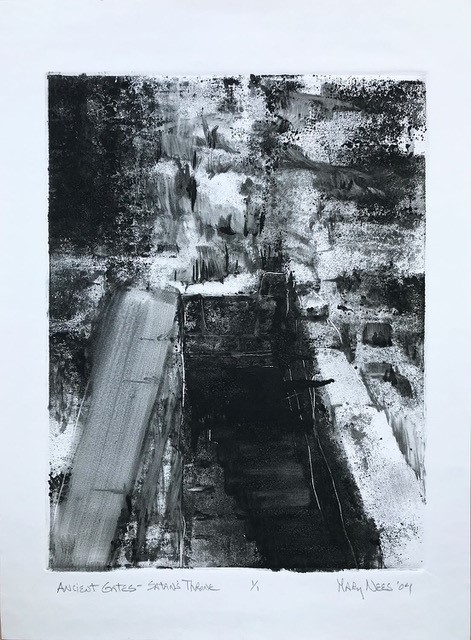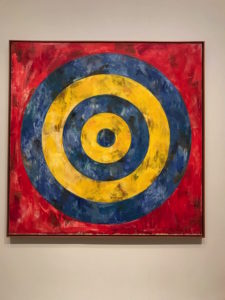 Jasper Johns’ 66 inch square piece is showcased at the Art Institute of Chicago and it jogged some thought. Johns’ intention when he made this and several other target images in the 60’s, was that viewers would see something familiar, “something the mind already knows” as a bridge or a catalyst toward further meaning. He was using the known to pry loose more that is not yet grasped.
Jasper Johns’ 66 inch square piece is showcased at the Art Institute of Chicago and it jogged some thought. Johns’ intention when he made this and several other target images in the 60’s, was that viewers would see something familiar, “something the mind already knows” as a bridge or a catalyst toward further meaning. He was using the known to pry loose more that is not yet grasped.
Jasper’s approach here was a significant departure from the way celebrated American artists were working at the time.
Johns was seeking to communicate. The Abstract Expressionists before him insisted primarily that there was nothing to communicate, only to express (hence Jackson Pollock would usually only number and not title his work). Johns instead was involving the viewer in an investigation. His own expression was not the end point but rather he made things with a certain interest in the receiver of His work. He also was demonstrating an expectation that there were things still discoverable that were valuable. The Abstract Expressionists, on the other hand, were a product of post-war deflation of ideas and of hope (even as some of their work is filled with exquisite gestures of communicative interest in spite of their claims otherwise).
Johns turns a corner on their insistent meaninglessness. He and his friend Robert Rauschenberg used popular signals to prompt the viewer. In fact in the detail here you can see how his medium is part of the messaging. He has embedded newspaper bits into encaustic wax, which hints at much more than just target practice, more than just a simple billboard with primary colors.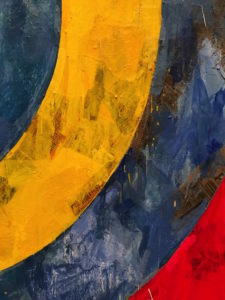
I am interested in how Johns seized his moment in history, reflecting on what was immediately vogue yet inadequate, and came up with a way forward. His way is not condescending to his audience, he is inviting them further along with him. That motivation is why this piece is so instructive.
The Abstracters left some damage in the wake of their insular assumptions. Many art newbies resist looking at non-objective work because they think they’re being played by an artist who cares little for their understanding, or who is in some stratosphere above their grasp. They shrink away, feeling belittled.
But Johns and Rauschenberg used common things to speak artfully. Their work was not simple even considering the commonness of items they used. Those common things were stepping stones, an invitation to dialogue with the eyes and with the mind.
To have regard for the viewer or the patron is sometimes mocked as pandering by artists who remain independent characters in any age. But to disdain anyone who stands before your work and not encourage their opportunity to critique and to explore is in my view elitist: a dead end rather than an offered target. The writer Brenda Ueland spoke of a certain necessary generosity with the craft. Her thoughts were a whole new way of encouraging the “why” of doing art for me. And Johns exhibits it.
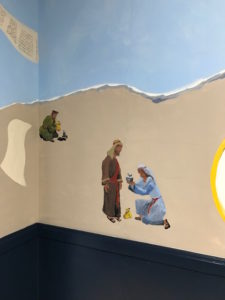 .
.
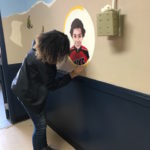
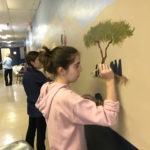

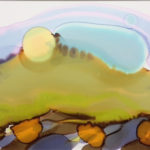 I will end the year with a simple post and a simple piece. After the workshop I taught, putting materials away, I decided to play on my own just a bit more. This one is a success and I matted it with an Emily Dickinson poem I have loved:
I will end the year with a simple post and a simple piece. After the workshop I taught, putting materials away, I decided to play on my own just a bit more. This one is a success and I matted it with an Emily Dickinson poem I have loved: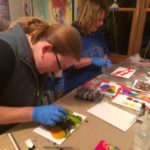
 Voila, or “There it is!” was the result after a couple hours of experimentation. We really are creative whether we understand how we’re made or not. The excitement in getting a glimpse of that is contagious. This finished result was just one of several little gems made that night. Liz illuminated a favorite quote from Brenda Ueland’s “If You Want to Write”: “Since you are like no other being ever created since the beginning of time, you are incomparable.”
Voila, or “There it is!” was the result after a couple hours of experimentation. We really are creative whether we understand how we’re made or not. The excitement in getting a glimpse of that is contagious. This finished result was just one of several little gems made that night. Liz illuminated a favorite quote from Brenda Ueland’s “If You Want to Write”: “Since you are like no other being ever created since the beginning of time, you are incomparable.”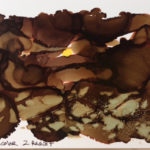
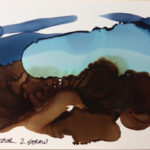 I am inserting here two little experiments with some inks for a workshop I’ll be conducting next week. Beginners will be introduced to some of the rationale behind abstraction’s promise. If some good work shows up from some of these craftsmen, I’ll be sure to post.
I am inserting here two little experiments with some inks for a workshop I’ll be conducting next week. Beginners will be introduced to some of the rationale behind abstraction’s promise. If some good work shows up from some of these craftsmen, I’ll be sure to post.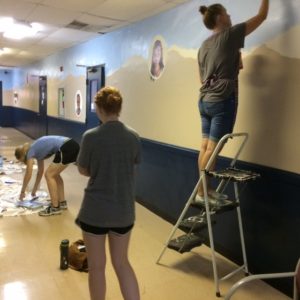 In some previous posts, I’ve highlighted the portrait work begun this summer for a community space, an after school refuge for kids. On a recent Saturday, a group of us gathered for several hours to paint in a basic background to set the avatars into a landscape. This entire tableau is going to be a storied timeline, further to be detailed and linked. Do I sound like I know what I’m doing? I laugh at the thought and my own chutzpah. I’ve never tackled something this big! But the stars aligned this year for the project. The ideas clicked, the grant money provided, the kids showed enthusiasm, and the time came available soon after I was asked to consider spearheading the venture. It’s going to come to a unified completion with a little help from friends. It’s way better together. Our goal is to have these two long hallway walls completed with all the elements by Christmas.
In some previous posts, I’ve highlighted the portrait work begun this summer for a community space, an after school refuge for kids. On a recent Saturday, a group of us gathered for several hours to paint in a basic background to set the avatars into a landscape. This entire tableau is going to be a storied timeline, further to be detailed and linked. Do I sound like I know what I’m doing? I laugh at the thought and my own chutzpah. I’ve never tackled something this big! But the stars aligned this year for the project. The ideas clicked, the grant money provided, the kids showed enthusiasm, and the time came available soon after I was asked to consider spearheading the venture. It’s going to come to a unified completion with a little help from friends. It’s way better together. Our goal is to have these two long hallway walls completed with all the elements by Christmas.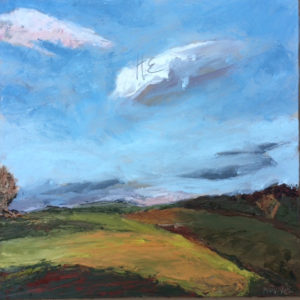 The small painting inserted here got finished today. It is one from the series I mentioned last post. Looking up is not the anesthesia of escape artists. It is rather a choice, based on sure evidence made more necessary in darkening times. It looks
The small painting inserted here got finished today. It is one from the series I mentioned last post. Looking up is not the anesthesia of escape artists. It is rather a choice, based on sure evidence made more necessary in darkening times. It looks 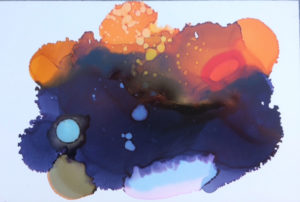 I struggle with my own voice in my work, living as I do in such a time of disintegration. I cannot make the work of my hands “say” what I hold in my heart so often. It is not my goal to be literal, but it is a desire to lift the viewer’s eyes. A friend of mine who is a photographer, grieving deeply over the death of her husband is now doing the best work of her career. We talked of this: why are we doing this work, this searching with images? Is it meaningful, is it what we “should be doing”? We got this far in our discussion: this work is an exploration into JOY. This expression is as fleeting as a sunset and as mysterious as a bird’s flight, but it is necessary, if even just for us. I have some ability to look, and to craft. Maybe through the work of my own hands others will see meaningfully also. For this, I keep on.
I struggle with my own voice in my work, living as I do in such a time of disintegration. I cannot make the work of my hands “say” what I hold in my heart so often. It is not my goal to be literal, but it is a desire to lift the viewer’s eyes. A friend of mine who is a photographer, grieving deeply over the death of her husband is now doing the best work of her career. We talked of this: why are we doing this work, this searching with images? Is it meaningful, is it what we “should be doing”? We got this far in our discussion: this work is an exploration into JOY. This expression is as fleeting as a sunset and as mysterious as a bird’s flight, but it is necessary, if even just for us. I have some ability to look, and to craft. Maybe through the work of my own hands others will see meaningfully also. For this, I keep on.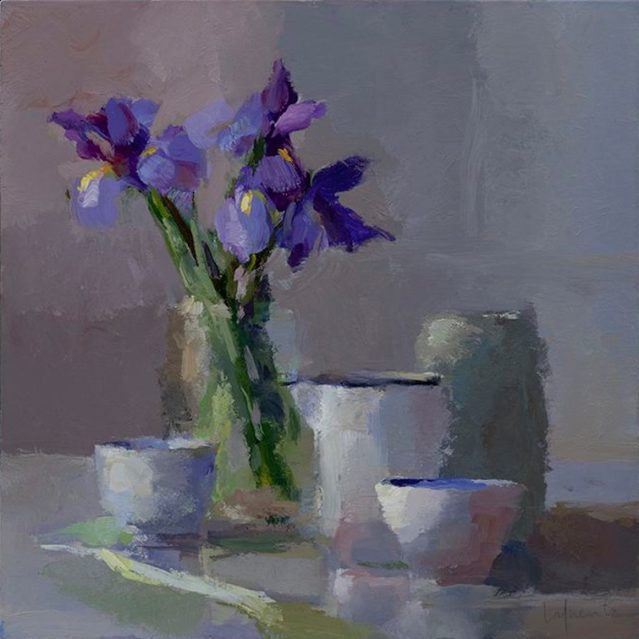
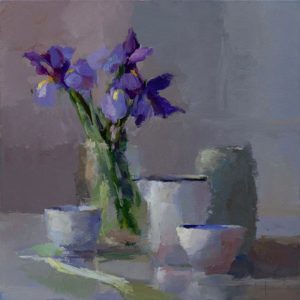 The settings are dim, completely uninteresting on their own. So, the piercing bits of beauty are apprehended all the more. Her gestural gems are gathered out of mud. It’s the boring that gives the beauty its chance to captivate. To me her work is a parable, a picture of the distinctiveness between that which shines, and that which is only a passing setting.
The settings are dim, completely uninteresting on their own. So, the piercing bits of beauty are apprehended all the more. Her gestural gems are gathered out of mud. It’s the boring that gives the beauty its chance to captivate. To me her work is a parable, a picture of the distinctiveness between that which shines, and that which is only a passing setting.